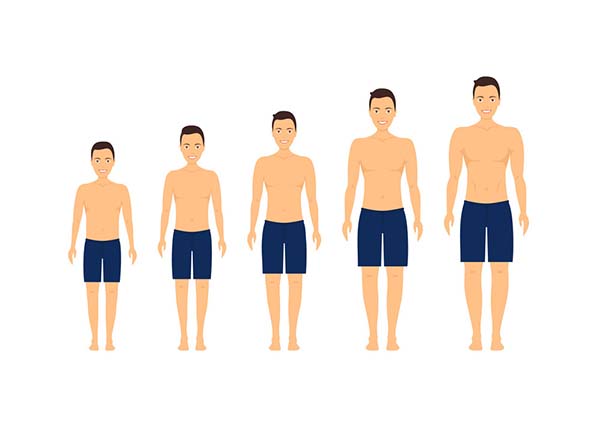That a person increases their height slowly or stops growing taller during their growing years is the worst nightmare for not only parents but also teenagers. Childhood and adolescence are the two periods in which height increases profoundly, and if said scenario happens, you or your children will end up having short stature. I know we all say things like “don’t judge a book by its cover”, but deep down, everyone wants their appearances to match what society considers beautiful, and that includes having an ideal height.
Despite this, a large proportion of people still make mistakes regarding their lifestyles that potentially stunt growth and prevent them from achieving their height potential. If you do not want this to happen to you, read on to find out 7 reasons why some people fail to grow taller.
Unawareness of your growth spurts
There are 3 periods of growth spurts throughout the life of every human being, specifically:
- Fetal period: During the 9 months of pregnancy, if mothers are well-nourished and increase their weight by 10-20 kg, their children will reach 50 cm in height upon birth and weigh more than 3 kg.
- From the neonatal period to 3 years of age: Children’s height grows by 25 cm in the first 12 months of age and 10 cm annually in the next 2 years given that they are well nurtured. While you cannot influence your height in these two periods, whether you will become tall or short lies in your hands in the third period.
- Puberty: This period takes place at 12-18 years of age in boys and 10-16 years of age in girls. During puberty, teenagers will have 1-2 years of extremely fast height increase from 8 to 12 cm a year if they receive proper nutrition and healthcare. In reality, however, we are unaware of the exact year when this growth spurt happens, and for this reason, the only way to foster optimal growth is to ensure sufficient nutrition for your body throughout this puberty period. Even though your height can still increase after puberty, the growth rate is terribly slow and the added height is negligible.

It is a myth that you can no longer grow taller after puberty; yet, post-pubertal height growth would occur slowly and require heavy external influences such as exercise, diet as well as height growth supplements.
Excessive exercise
Although exercising is one of the best ways to increase height, it should be practiced moderately and appropriately depending on individual physical conditions. Excessive exercise should accordingly be avoided at all costs as it results in adverse effects on both your overall health and height development. In fact, excessive exercise will cause bone injuries and bone sequelae, which eventually slows or even stunts your height growth.
Indulgence in fast food and/or carbonated drinks
Not growing as tall as your peers, it’s time to peep into your lunch box. Eating fast food or junk food regularly has negative impacts on children’s and teenagers’ health to a large extent, from making them sluggish in the classroom to stunting their growth. Besides, junk food is a major cause of obesity, which in turn hinders the height gain process for children and teenagers.

Carbonated drinks, on the other hand, is an accomplice with fast food in slowing or stunting height growth. The air bubbles in carbonated soft drinks increase urinary calcium excretion and would lead to calcium deficiency in the body, thereby adversely affecting height growth in young people and increasing the risk of bone and joint diseases among the elderly.
Furthermore, how many times has drinking carbonated drinks made you feel full? Indeed, the amounts of sugar and carbon dioxide in these drinks engender abdominal fullness, which possibly causes anorexia and nutritional deficiency in children and teenagers. In addition, carbonated drinks are detrimental to the functions of various organs in the body and your general health, including tooth decay, digestive disorders, destroying tooth enamel, and damaging the gastric mucosa.
Lack of essential nutrients
The increasingly busy lifestyle barely leaves parents with time to cook for their families and forces them to resort to fast food or highly processed foods, the major reason for teenagers’ and children’s growing reliance on these unhealthy meals.
What results from this eating habit is nutritional imbalance that deprives the body of essential nutrients such as vitamins, minerals, and fiber whereas the amounts of harmful substances like saturated fat and food additives become excessive. This is responsible for stunted growth in children, weakened immune system, and smaller stature compared with their peers.
We all know that nutrition plays as important a role as genetics in determining how tall you will become. As a result, building a nutritious diet for children and teenagers is of vital importance. A healthy nutritious diet should include 4 essential nutrients, namely proteins, fat, vitamins, and minerals. In particular, proteins and fat generate energy for the body while vitamins and minerals help different functions within the body work effectively, thus stimulating height increase.
Staying up late
Have you ever stayed up until 3 a.m. to binge-watch your favorite TV shows? If your answer is yes, here’s some bad news for you. Staying up late over a period of time is directly linked with poor height growth. Generally, it is during sleep, usually from 11 p.m. to 1 a.m., that the pituitary gland secretes growth hormone at peak levels.
Staying up late means that you rob your body of a large amount of growth hormone to grow taller. To avoid this, it is advisable that you get into the habit of sleeping early, preferably before 11 p.m., during your growing years to maximize your height growth.

Sedentary lifestyle
That the current educational conditions and living space are getting narrower facilitates a sedentary lifestyle among children and teenagers in which they become inactive and opt for a book, video game, or movie instead of going out or playing sports. This lack of physical activities is another reason for stunted growth in children and adolescents.
To tackle this problem, parents need to encourage their children to play sports such as basketball, volleyball, swimming, football, yoga or jumping. Some household chores such as cleaning the house, washing clothes or dishes should be encouraged because they are a great way to trigger muscle activity and movement. Outdoor activities also help children absorb more vitamin D which enhances calcium absorption for bones.
Chronic stress
The last but not least reason why you cannot grow taller is chronic stress. Prolonged periods of stress because of work or school make the body severely exhausted, reduce bone density, and ultimately deter height gain.
In addition to stress, other psychological traumas when a child is mistreated or abused in the past also take a toll on their physical development. Therefore, children and teenagers need to be nurtured and educated in a healthy environment in order to achieve optimal physical and mental development.
Knowing the reasons for slowed or stunted growth can save you from having short stature. By avoiding or breaking these bad habits together with building a balanced and nutritious diet, exercising regularly, and sleeping early, you can facilitate optimal height growth and reach or even surpass your genetic height potential.
